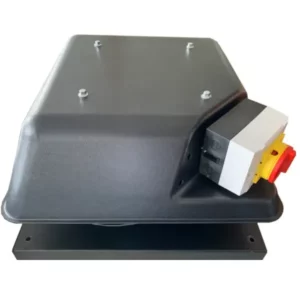An axial roof fan, also known as an axial exhaust fan or rooftop axial fan, is a type of ventilation fan that is specifically designed to be installed on the roof of a building or structure. It is commonly used to exhaust air from industrial and commercial facilities, including warehouses, factories, workshops, and larger indoor spaces.
The term “axial” refers to the airflow direction created by the fan. Axial fans move air parallel to the fan’s axis of rotation, pulling or pushing air in a linear direction. This is in contrast to centrifugal fans, which move air radially outward from the center of the fan.
Here are some key features and characteristics of axial roof fans:
- Design: Axial roof fans consist of a series of blades or impellers mounted on a hub, enclosed within a protective housing or shroud. The blades are typically aerodynamically designed to efficiently move large volumes of air.
- Roof Mounting: These fans are specifically designed to be installed on the roof of a building. They are often equipped with weather-resistant features to protect against moisture, rain, and other external elements.
- Airflow and Ventilation: Axial roof fans are primarily used for ventilation and air extraction. They are capable of moving large volumes of air and are effective in removing stale air, pollutants, heat, or moisture from the interior of a building. This helps maintain a comfortable and healthy indoor environment.
- Size and Capacity: Axial roof fans are available in a range of sizes and capacities to suit different ventilation requirements. The size and capacity of the fan depend on factors such as the size of the space, the desired airflow rate, and the specific ventilation needs of the facility.
- Energy Efficiency: Many modern axial roof fans are designed to be energy efficient, incorporating features such as variable speed controls, high-efficiency motors, and aerodynamic blade designs. This helps minimize energy consumption while maintaining effective ventilation.
- Noise Levels: Axial roof fans can generate noise due to the movement of air and the rotating blades. However, manufacturers often design them with noise-reducing features to minimize sound levels, making them suitable for applications where noise control is important.
- Installation and Maintenance: Axial roof fans are typically designed for easy installation and maintenance. They are often equipped with mounting brackets or flanges for secure attachment to the roof structure. Regular maintenance, including cleaning and inspection of the fan and its components, is necessary to ensure optimal performance and longevity.
Axial roof fans play a crucial role in maintaining proper air circulation and ventilation in various industrial and commercial settings, helping to remove pollutants, control temperature, and improve overall air quality.
How does axial roof fan work?
An axial roof fan, also known as a rooftop axial fan, is a type of ventilation fan that is specifically designed for installation on the roof of a building. These fans are used to exhaust air, fumes, heat, or odors from the interior of a building and expel them to the outside. The working principle of an axial roof fan involves the following components and processes:
- Fan Housing: The fan housing is the outer casing that encloses the fan blades and motor. It is typically designed to be weatherproof and constructed with materials that can withstand outdoor conditions.
- Motor: The fan is powered by an electric motor that is located inside the fan housing. The motor drives the rotation of the fan blades to create airflow.
- Fan Blades: An axial roof fan consists of multiple blades arranged in a propeller-like configuration. These blades are designed to generate airflow by pushing air in a straight line parallel to the fan’s axis. When the motor rotates the blades, they draw air in from the surrounding environment and expel it vertically or horizontally, depending on the fan’s orientation.
- Airflow Direction: The axial roof fan maintains a consistent direction of airflow parallel to the fan’s axis. It draws air in from the top or sides of the fan housing and exhausts it vertically or horizontally, depending on the fan’s design and installation orientation.
- Roof Mounting: Axial roof fans are specifically designed for installation on the roof of a building. They are typically equipped with a base or flange that allows secure attachment to the roof structure. Proper weatherproofing measures, such as sealing the fan housing and ensuring the fan’s structural integrity, are implemented to prevent water ingress and ensure safe operation in outdoor environments.
- Ventilation and Exhaust: The primary purpose of an axial roof fan is to provide ventilation and exhaust capabilities. These fans are commonly used to remove stale air, heat, smoke, fumes, or odors from the building interior. The generated airflow helps to improve indoor air quality, control temperature, and remove unwanted contaminants.
- Optional Accessories: Depending on the specific application, axial roof fans can be equipped with additional accessories to enhance their performance. These may include features such as louvers, dampers, or rain covers. Louvers or dampers help control the direction and volume of airflow, while rain covers protect the fan from water ingress during inclement weather.
Overall, an axial roof fan works by utilizing the rotational motion of the fan blades to create a flow of air parallel to the fan’s axis. It is specifically designed for rooftop installation to provide effective ventilation and exhaust capabilities for commercial and industrial buildings.

